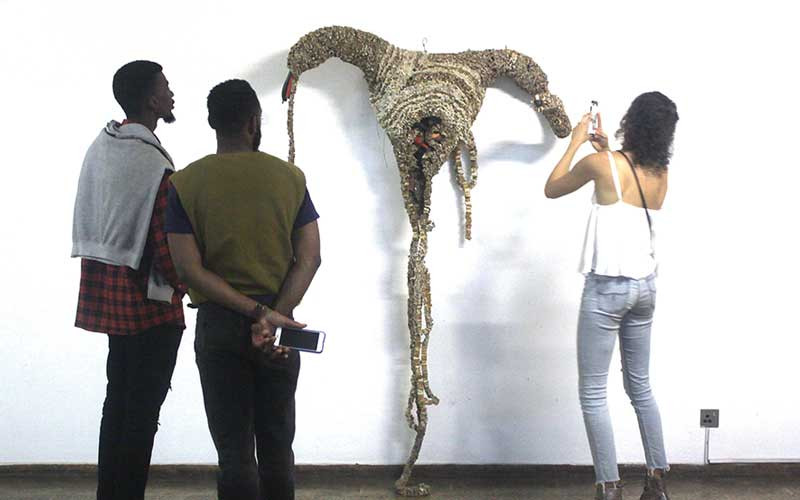
VISUAL artist Tawanda Takura finds beauty in decay in his solo exhibition at the National Gallery of Zimbabwe (NGZ) in Harare.
Takura’s exhibition is made up of work created out of cigarette stubs, old shoes and other discarded objects.
Titled Katundu Katurikwa, the exhibition pushes the envelope on the re-use of discarded objects.
Katundu is a Shona word that means possessions, luggage or baggage. Katurikwa is also a Shona word referring to something hung. The title of the exhibition can mean that the baggage is hung somewhere out of view for safe-keeping, or hung out for all to see.
In the context of the show, the exhibition of the artworks suggests the artist is finally laying bare emotional burdens that were previously held close to the heart.
The artist said his inspiration comes from the community and people who shared with him their personal stories of unresolved issues from the past and the present.
Takura empathises with his subjects' trauma as he relates to his own vulnerabilities, confessing how he had to deal with the loss of his parents at a young age.
“I feel as though I am spiritually and emotionally naked ever since,” he noted.
- Daily life struggles reflected in Burning Figure
- There is life in paint and brush: Chaumbezvo
- Luke Snow's artworks offers musicians business idea
- Zuze’s images exude self-expression, individuality
Keep Reading
In his quest to find meaning, Takura analyses cast-offs from people’s lives and distils their essence.
Dispassionately, he dissects his medium like a surgeon getting down to the root of a problem.
“Every unit of material I use resembles an individual who used them since they carry their residue,” he said.
One of the prominent artworks on display is a giant cross-section of female reproductive organs. The piece, made out of cigarette stubs, clinically shows the womb, fallopian tubes, urethral canal and the vulva.
The womb is filled with stilettos that seem to represent a future generation of women waiting to be born. Smoking is a harmful habit that is not good for the body and can lead to lung cancer. The toxic environment resulting from the left-over stubs brings a question over productivity and long-term side effects.
Shoes can represent humanity’s embodiment of character, personality and circumstances in life. New shoes smell nice and look pretty. After much use, they lose their shine, acquire scratches and give out a repulsive odour. Eventually they are cast out because they have grown out of favour with the owner.
After they have been exposed to the elements and decay, Takura finds aesthetic value in the discarded shoes.
Murudo Murudo is a phrase which was previously used by Nothando Chiwanga and Grace Nyahangare as a title for their respective artworks.
Literally, the Shona phrase is a double take: “In love, in love.” In urban lingo it means “one love” with a cynical take that sometimes things are not what they seem to be.
The statement has been used with regretful hindsight over fake friends and false promises and also with criticism for those who collude in engaging in such vices as consumption of drugs.
For Takura, it has been translated into a staff with old heels and stilettos impaled on it and a phallic baton stick at the top. At the bottom is a creepy inverted doll which may invoke the unborn.
Chirombo Mwari is a vortex of stilettos spinning out of control like a tornado. With a gaping orifice at the head, it looks both sexy and dangerous.
Although inspired by a personal tragedy narrated to the artist, Nekuti Madzisekuru Ako can also be read in a wider context as relating to the impact of colonialism in Africa.
Discriminatory colonial labour laws in Rhodesia relegated black people to menial labour, resulting in Africans inheriting generational poverty that has been difficult for many families to break from.
Made from industrial latex gloves with the fingers entwined, and a winnowing basket, the artwork represents the figure of a man elevated against the wall in a lateral position.
In its reference to ancestors, the title seeks to trace the origins of the predicament. It also carries the notion that the ancestors need appeasement for the predicament to go away.
A huge installation made out of the tops from different types of shoes which include formal and sportswear is titled Soul Searching/Kuzvitsvara.
The title carries a double meaning, from the fact that the shoes are literally missing the underside of the footwear called the sole, while the artwork also invokes different types of personalities.
Another piece titled Tsvimbo Yemanenji 1 is made from an inverted staff and cascading stilettos, some of which have the iron piece that supports the sole hanging out like a dog’s tongue. It looks raw like the entrails of a strange beast. The Shona title suggests it represents a bad omen.
Successfully promoted through international breakthroughs by such artists as Moffat Takadiwa, Wallen Mapondera and Kresiah Mukwazhi, the movement in the use of found objects in the Zimbabwean visual art landscape is growing and evolving in innovative and interesting ways.







